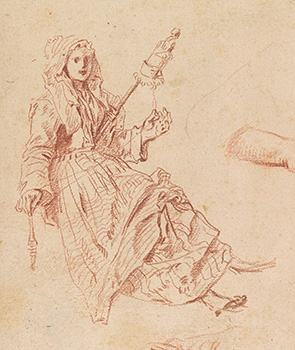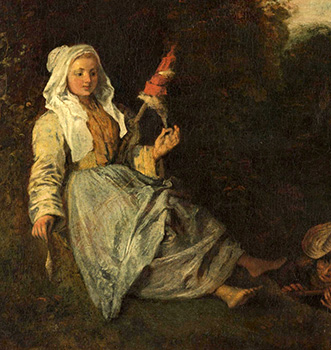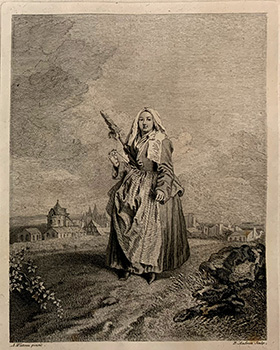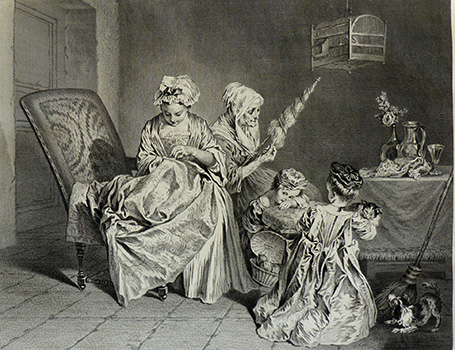
- Home Page
- Accepted
Paintings & Copies - Doubtful
Attributions - Doubtful Textual References
- Alternative
Titles - Collectors &
Museums - Bibliography
- Search Abecedario
- Watteau &
His Circle
L’Indiscret
Entered December 2024
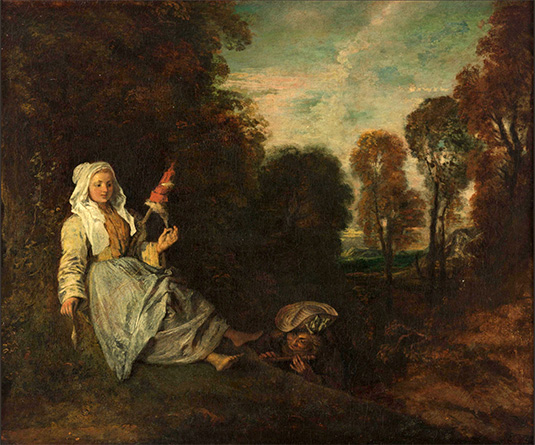
Rotterdam, Museum Boijmans-van Beuningen, inv. 2588
Oil on canvas
55 x 66 cm
ALTERNATIVE TITLES
Avondschap met Spinster
Evening Landscape with Spinner
Landscape at Evening
The Spinner
Der Vowitzige
RELATED PRINTS
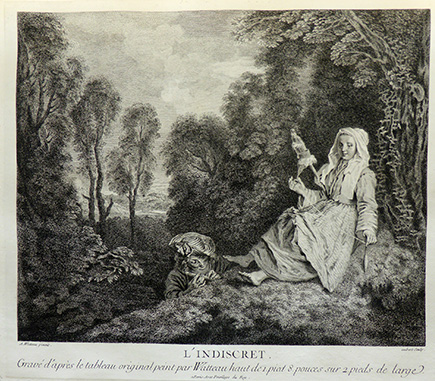
L’Indiscret was engraved in reverse by Michel Aubert. As it was not announced for sale in the Mercure, the print cannot be securely dated.
PROVENANCE
Amsterdam, with Jacques Goudstikker (1897-1940; art dealer).
Vierhouten, collection of Daniel Georg van Beuningen (1877-1955; coal industrialist), purchased in 1937.
Rotterdam, Boymans Museum, acquired with the Van Beuningen collection in 1958.
EXHIBITIONS
Rotterdam, Boymans Museum (1938), Meesterwerken uit vier eeuwen, 1400-1800, cat. 199 (as by Watteau, Avondlandschap met spinster, lent by D. G. van Beuningen, Rotterdam).
The Hague, Mauritshuis, Herwonnen Kunstbezit (1946), cat: 256 (as by Watteau, Avondlandschap met spinster).
Paris, Petit Palais, Chefs d'œuvre de la collection van Beuningen (1952), cat. 163 (as by Watteau, L’Indiscret, lent by the van Beuningen collection).Rotterdam, Museum Boijmans Van Beuningen. Kunstschatten uit Nederlandse Verzamelingen (1955), cat. 173 (as by Watteau, L’Indiscret, lent by D. G. van Beuningen, Vierhouten).
London, Royal Academy, France in the Eighteenth Century (1968), cat. 723 (as by Watteau, Landscape at Evening, lent by the Boymans-van Beuningen Museum, Rotterdam).
Washington, Paris, Berlin, Watteau 1684-1721 (1984), cat. P. 31 (as by Watteau, Indiscreet (L’Indiscret), lent by the Museum Boymans von Beuningen, Rotterdam).
Dijon, Musée des beaux-arts, Chefs-d’oeuvre de la peinture fran̨caise des musées néerlandais (1992),cat. 48 (as by Wattteau, L’Indiscret, lent by the Museum Boymans-van Beuningen, Rotterdam).
Brussels, Palais des beaux-arts, Watteau, Leçon de musique (2013), cat. 19 (as by Watteau, L’Indiscret, lent by the Museum Boijmans van Beuningen, Rotterdam).Frankfurt and Rotterdam, Watteau: Der Zeichner (2016), cat. 33 (as by Watteau, L’Indiscret [Der Vowitzige], lent by the Museum Boijmans Van Beuningen, Rotterdam).
SELECT BIBLIOGRAPHY
Hédouin, “Watteau” (1845), cat. 102.
Hédouin, Mosaïque (1856), cat. 103.
Goncourt, L’Art au XVIIIème siècle (1860), 58.
Thoré-Burger, “Exposition de tableaux” (1860), 233.
Goncourt, Catalogue raisonné (1875), cat. 189.
Mollet, Watteau (1883), 73.
Josz, Watteau (1903), 320, 322.
Dacier, Vuaflart, and Hérold, Jean de Jullienne et les graveurs (1921-29), 1: 262; 2: 68, 69, 94, 95, 122, 131; 3: cat. 121.
Réau, “Watteau” (1928), cat. 171.
Adhémar, Watteau (1950), cat. 165.
Mathey, Watteau, peintures réapparues (1959), 50, 68, cat. 133.
Nemilova, Watteau and His Works (1964), 109.
Nemilova, “Essays on the Work of Antoine Watteau" (1964), 84-98.
Cailleux, “Four Artists” (1966), ii.
Hoetink, “Three Centuries of French Art” (1967), 50, 52.
Macchia and Montagni, L’opera completa di Watteau (1968), cat. 140.
London, Wallace Collection, Pictures and Drawings (1968), 369.
Ferré, Watteau (1972), cat. B 23.
Kettering, “Rembrandt's ‘Flute Player'” (1977), 42-43.
Banks, Watteau and the North (1977), 189-90.
Roland Michel, Watteau (1981), cat. 181.
Washington, Paris, Berlin, Watteau 1684-1721 (1984), 321, 534-35, cat. 31.
Posner, Watteau (1984), 26-7; 279, n. 28; 290, n. 51.
Démoris, ”Watteau, le paysage et ses figures” (1987), 157-62.
Nicholas, The Rape of Europa (1994), 111.
Rosenberg and Prat, Watteau, Catalogue raisonné des dessins (1996), 227, 461.
Wintermute, Watteau and His World (1999), cat. 7.
Temperini, Watteau (2002), 65, cat. 61.
Wyngaard, From Savage to Citizen (2004), 63-64.
Rotterdam, Museum Boijmans, The Collection (2005), 96.
Michel, Le «célèbre Watteau» (2008), 183, 209-10.
Glorieux, Watteau (2011), 139.
RELATED DRAWINGS
Remarkably, the drawings for both figures in L’Indiscret have survived.
Although the woman is well defined and the principal figure in the painting, she was based on a sketchy rendering on a sheet of studies now in the Pierpont Morgan Library and Museum (Rosenberg and Prat 227). The artist prepared other studies from the same model.
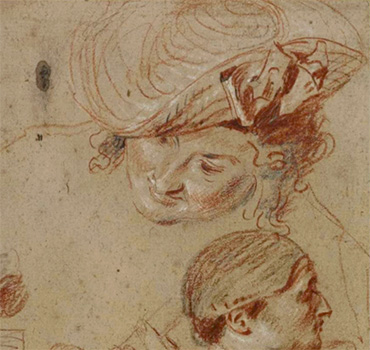
Watteau, Sheet of Studies of Heads (detail), red chalk, Rouen, Musée des beaux-arts,
det.jpg)
Watteau, L’Indiscret (detail).
The flutist in L’Indiscret was first studied on a sheet now in the Rouen museum (Rosenberg and Prat 461). Drawn as almost separate studies of the head and hands, these motifs are crowded into the upper right corner of the page, and may have been drawn before the other five studies, which fill the rest of the sheet.
REMARKS
The painting now in the Boijmans van Beuningen Museum is recognized by critics as autograph. Typical of Watteau's works, the picture is not well preserved. While some sense of the artist’s brushwork and color survives in the figure of the shepherdess, the remainder of the painting is sunk into dark obscurity. Like so many of Watteau’s earlier paintings, oxidization has taken its toll. Its exhibition in the 1930s under the title of Evening Landscape (occasionally still used today) reflects the painting’s deteriorated condition. Although the picture was conserved before the 2016 exhibition, its present state is still deplorable.
Although the Aubert engraving was included in Jean de Jullienne’s Oeuvre gravé, L’Indiscret received little public attention. Essentially, it remained hidden from sight for its first two hundred years. It went unseen, probably in private collections, until shortly before World War II.
There have been several attempts, none convincing, to identify paintings sold in the eighteenth century as L’Indiscret. One such work, sold April 17ff, 1778, featured a picture supposedly by Watteau and showing a male flutist sitting next to a woman, but that picture was on a wood panel and measured only 27 x 22.9 cm, half the size of the Rotterdam picture. Another sale reference that has been linked to L’Indiscret is a picture sold on December 10ff, 1778, and which was described as showing a woman seated next to a male flutist, who was also seated and placed below her. However, there is no mention of her most obvious attribute—her spindle—and she was looking down at him. That description identifies the composition as La Lorgneuse. Also, the Wallace Collection proposed that a painting lent by Richard Wallace to a Paris exhibition in 1860 was L’Indiscret. But that painting, as catalogued and as described by Thoré-Burger, showed a standing peasant woman with a distaff, and thus it corresponds to another Watteau composition, one engraved under the title of La Fileuse.
Adhémar claimed that the Rotterdam painting had been with the dealer Jules Feral (1874-1944) and had appeared in one of his postwar sales. She presumably meant in a post-World War I sale. Her vague reference has not been verified, yet it has been reiterated in the museum’s 1955 exhibition catalogue, the tricentenary exhibition in 1984, and the 2013 exhibition in Brussels. However, it has been dropped in other recent catalogues such as the ones in London in 1968 and Frankfurt in 2016.
The subject of L’Indiscret—a rustic peasant woman posed with her distaff and spindle—is unusual but not unique in Watteau’s oeuvre. The artist essayed such peasants on other occasions, as in his painting La Fileuse. Furthermore, his painting of feminine activities, L’Occupation selon l’age, includes an old woman with a spindle. L’Indiscret fits well into this theme of rural occupations.
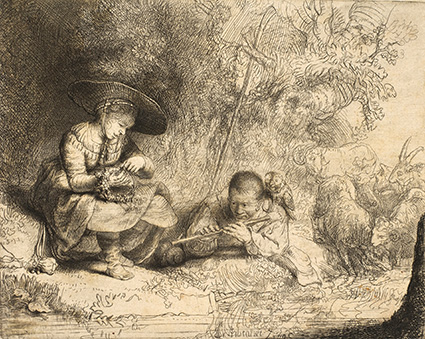
Rembrandt van Rijn, The Flutist, 1642, etching.
Our present understanding of L’Indiscret is due in large measure to Mathey’s realization that Watteau’s composition is based upon Rembrandt’s etching, The Flutist. Both works focus on a shepherdess with her distaff and spindle, and a man lying near her feet, looking up her skirt. That Watteau depended so much on Rembrandt’s design is extremely unusual, especially given that he emulated the art of Rubens, Van Dyck, Kalf, Teniers, and other Northern masters, but his interest in Rembrandt was negligible. That he chose such an erotic, salacious narrative is even more unexpected.
To what degree was Watteau influenced by Rembrandt’s etching? Was it only a matter of its composition, or was Watteau also aware of the symbols and sexual innuendos in Rembrandt’s print? Recent scholarship has emphasized the erotic iconography embedded within both Rembrandt’s and Watteau’s works. The phallic implication of the flute and the vaginal implication of the wreath woven by the shepherdess have received much attention. Rembrandt aside, did such iconographic games of allusion interest Watteau? Do we even know his sexual preferences?
Following a well-established tradition asserting that such rustic, Netherlandish subjects were executed in the early part of Watteau’s career, Mathey dated the painting to c. 1712-13. However, most recent scholarship has more reasonably favored a date around 1715-17.
For copies of L'Indiscret, CLICK HERE
